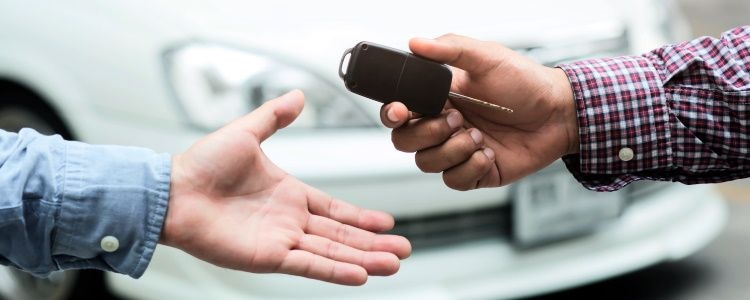A voluntary surrender is like a repossession – only you choose to turn in the vehicle instead of waiting for the repo company to take it away. Here's what typically happens after you voluntarily surrender your car.

What Happens if I Voluntarily Surrender My Car?
After a Voluntary Surrender
After you surrender your car, the lender typically puts it in storage before it’s sold privately or at auction to try to recover the loan balance still left on the vehicle. You’re typically required to pay those storage fees, and many storage companies charge daily.
Before an auction, your lender is required to let you know when and where the car is being sold. You have the right to bid on the vehicle and win it back – but if you win, you’re still responsible for the total loan balance and additional fees associated with the surrender.
Hope the sale proceeds are enough to cover your remaining loan balance – if there’s still a balance (called a deficiency balance) you’re also responsible for paying it. For example: if your car sells for $5,000, but you owe $8,000 on your loan, you still owe the lender that $3,000 plus additional fees associated with the surrender.
The voluntary surrender is reported on your credit reports as a repossession. And if you choose to surrender the car because you defaulted on the loan, the default is also listed on your credit reports. However, a future auto lender may view a voluntary surrender more positively than a traditional repo, because you took initiative and returned the car yourself.
A repossession is reported on your credit reports for up to seven years. You may struggle to get another car loan from traditional and subprime lenders for up to a year after the surrender. However, negative marks on your credit reports have less and less impact on your overall credit rating over time. One year from the surrender date, subprime lenders are more likely to consider you for an auto loan approval as well.
Voluntary Surrender vs. Repossession
 In many ways, voluntary surrender and traditional repossession are similar. Both are reported as repossessions on your credit reports and harm your credit score. However, a voluntary surrender saves you some money.
In many ways, voluntary surrender and traditional repossession are similar. Both are reported as repossessions on your credit reports and harm your credit score. However, a voluntary surrender saves you some money.
When a recovery company is hired to tow your vehicle away, someone has to pay for that (hint: it’s not your lender). You’re responsible for paying the recovery company, and this cost can vary, but it’s usually around $200 to $500 per tow.
Another benefit to voluntarily surrendering your car is that you can drop it off at your convenience. Repo companies can take your vehicle from almost anywhere. They could take it while you’re out and about, turning a regular outing into a huge hassle. However, when you surrender your car, you can take time to remove all your belongings, drop it off when it’s convenient for you, and you can plan ahead for future transportation.
If you know that repossession is around the corner, then a surrender can save you some money and a future headache.
Before You Surrender Your Vehicle
A voluntary surrender should be considered a last resort. If you haven’t yet contacted your lender about your options or received notices about an impending repossession, consider these tactics:
- Ask for a deferment – A deferment temporarily pauses your loan payments, usually up to three months. If you’re hitting hard times, write a hardship letter outlining why you require a deferment and contact your lender before you’ve missed a payment. The quicker you act, the more likely they are to accommodate your situation. The payments that you “skip” during a deferment aren’t forgiven, though, and they’re usually added to the back of your car loan. Some lenders may still require you to pay interest charges while payments are paused, so be sure to ask your lender what their policies are regarding deferments.
- Opportunity to cure/reinstate – If you’ve missed a payment already, you may still have the opportunity to cure your auto loan. This typically involves making up all missed or late payments to reinstate the loan, but not everyone has this option so be sure to check with your lender.
- Refinance the vehicle – If you’re having trouble keeping up with payments and worried about default, then refinancing could help. Refinancing replaces your current loan with another one, and most borrowers refinance to get a lower monthly payment. This is done by either lowering your interest rate or extending the loan term. While extending the loan term without lowering your interest rate increases how much you pay for the vehicle overall, it’s arguably a better option than default and repo.
- Redeem the loan – This isn’t typically an option for everyone, but you may be able to redeem the car by paying off your entire remaining loan balance. Some lenders may be willing to negotiate the loan balance, as well. Again, the sooner you contact your lender, the more likely they may be to work with you.
- Sell the car – A voluntary surrender or repossession can have a devastating impact on your future credit opportunities, so it may be wise to consider selling the car before you surrender it yourself. If you can get a large enough offer for your vehicle that covers your loan balance, you can avoid default and subsequent repo and heavy credit score damage.
Need to Sell or Finance? Let Us Help
At Auto Credit Express, we’ve created a nationwide network of dealerships that are signed up subprime lenders. These lenders assist borrowers in many bad credit circumstances, including a past repo. If you need another auto loan but your low credit score is getting in the way, then we want to help.
Fill out our free auto loan request form, and we’ll look for a local dealer that has the resources to assist with credit challenges.

Senior Auto Financing Editor
Suggested Posts For You
Receive Free Updates
Get the latest credit tips, resources and advice delivered straight to your inbox.













